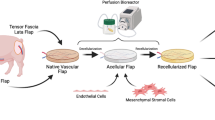Abstract
An experimental study was conducted to determine whether pericardial fat tissue could induce neovascularization and produce cytokines related to tissue repair. Neovascularization was examined using chick chorioallantoic membranes. Pieces of pericardial fat tissue, omentum, and intercostal muscle were individually placed on a number of chorioallantoic membranes and neovascularization induced by each material was assayed 6 days after the implantation. The intensity of neovascularization was in the order of pericardial fat ≥ omentum > muscle. Cytokines, such as interleukin 1 (IL-1) α and β, tumor necrosis factor-α (TNFα), interferon-γ (IFN-γ), and interleukin 6 (IL-6) were assayed in a culture supernatant of pericardial fat tissue. The latter was obtained 24h after the addition of lipopolysaccharide (LPS) following various incubation times. All cytokines other than IFNγ are known to play a part in tissue repair, whereas IFNγ is negatively related to tissue repair because it inhibits fibroblast growth. The pericardial fat tissue incubated with LPS produced a certain amount of IL-1 on day 1, and TNFα on days 1 and 8, whereafter these values decreased to an undetectable level. Irrespective of the addition of LPS, a large amount of IL-6 was observed in the supernatant of pericardial fat tissue and it was detectable until day 29. On the contrary, INFγ was not detected at any assay time. These observations suggest that a pericardial fat pad flap could possibly be beneficial in the prevention of bronchopleural fistula after pulmonary resection.
Similar content being viewed by others
References
Asamura H, Naruke T, Tsuchiya R, Goya T, Kondo H, Suemasu K (1992) Bronchopleural fistulas associated with lung cancer operations. J Thorac Cardiovasc Surg 104:1456–1464
Burkes RL, Ginsberg RJ, Shepherd FA, Blackstein ME, Goldberg ME, Waters PF, Patterson GA, Todd T, Pearson FG, Cooper JD, Jones D, Lockwood G (1992) Induction chemotherapy with mitomycin, vindesine, and cisplatin for stage III unresectable non-small cell lung cancer: Results of the Toronto phase II trial. J Clin Oncol 10:580–586
Morgan E, Lima O, Goldberg ME, Ferdman A, Luk SK, Cooper JD (1982) Successful revascularization for totally ischemic bronchial autografts with omental pedicle flaps in dogs. J Thorac Cardiovasc Surg 84:204–210
Cartier R, Brunette I, Hashimoto K, Bourne WM, Schaff HV (1990) Angiogenic factor: A possible mechanism for neovascularization produced by omental pedicles. J Thorac Cardiovasc Surg 99:264–268
Brewer LA, King EL, Lilly LJ, Bai AF (1953) Bronchial closure in pulmonary resection: a clinical and experimental study using pedicled pericardial fat graft reinforcement. J Thorac Surg 26:507–532
Schmidt JA, Mizel SB, Cohen D, Green I (1982) Interleukin 1, a potential regulator of fibroblast proliferation. J Immunol 128:2177–2182
Dinarello CA (1988) Biology of interleukin 1. FASEB J 2:108–115
Mahadevan V, Hart IR, Lewis GP (1989) Factors influencing blood supply in wound granuloma quantitated by a new in vivo technique. Cancer Res 49:415–419
Sauder DN, Kilian PL, McLane JA, Quick TW, Jakubovic H, Davis SC, Eaglstein WH, Mertz PM (1990) Interleukin I enhances epidermal wound healing. Lymphokine Res 9:465–473
Vilcek J, Palombella VJ, Henriksen-Destrefano D, Swenson C, Feinman R, Hirai M, Tsujimoto M (1986) Fibroblast growth factor enhancing activity of tumor necrosis factor and its relationship to other polypeptide growth factors. J Exp Med 163:632–643
Leibovich JS, Polverin PJ, Shepard MH, Wiseman DM, Shively V, Nuseir N (1987) Macrophage-induced angiogenesis is mediated by tumor necrosis factor-α. Nature 329:630–632
Heinrich PC, Castell JV, Andus T (1990) Review article: interleukin-6 and the acute phase response. Biochem J 265:621–636
Nishida T, Nakamura M, Mishima H, Otori T, Hikida M (1992) Interleukin 6 facilitates corneal epithelial wound closure in vivo. Arch Ophthalmol 110:1292–1294
Narayanan SA, Whithey J, Souza A, Raghu G (1992) Effect of γ-interferon on collagen synthesis by normal and fibrotic human lung fibroblasts. Chest 101:1326–1331
Icenogle TB, Levinson MM, Copeland JG, Emery RW (1986) Use of pericardial fat pad flap to prevent bronchopleural fistula. Ann Thorac Surg 42:216–217
Tsuchiya R, Goya T, Naruke T, Suemasu K (1990) Resection of tracheal carina for lung cancer. J Thorac Cardiovasc Surg 99:779–787
Mustoe TA, Pierce GF, Thomason A, Gramates P, Sporn MB, Deuel TF (1987) Accelerated healing of incisional wounds in rats induced by transforming growth factor-β. Science 237:1333–1336
Esch F, Baird A, Ling N, Ueno N, Hill F, Denoroy L, Klepper R, Gospodarowicz D, Böhlen P, Guillemin R (1985) Primary structure of bovine pituitary basic fibroblast growth factor (FGF) and comparison with the amino-terminal sequence of bovine brain acidic FGF. Proc Natl Acad Sci USA 82:6507–6511
Mayer E, Cardoso PFG, Puskas JD, De Campos K, Oka T, Dardick I, Patterson GA (1992) The effect of basic fibroblast growth factor and omentopexy on revascularization and epitherial regeneration of heterotopic rat tracheal isografts. J Thorac Cardiovasc Surg 104:180–188
Forrester-Wood CP (1980) Bronchopleural fistula following pneumonectomy for carcinoma of the bronchus. J Thorac Cardiovasc Surg 80:406–409
Yokomise H, Kobayashi J, Yagi K, Mizuno H, Inui K, Aoki M, Wada H, Hitomi S (1993) The treatment of postpneumonectomy bronchopleural fistula (in Japanese). Nippon Kokyuki Geka Gakkai Zasshi (J Jpn Assoc Chest Surg) 7:519–523
Author information
Authors and Affiliations
Rights and permissions
About this article
Cite this article
Ichinose, Y., Asoh, H., Yano, T. et al. Use of a pericardial fat pad flap for preventing bronchopleural fistula: An experimental study focusing on the angiogenesis and cytokine production of the fat pad. Surg Today 25, 811–815 (1995). https://doi.org/10.1007/BF00311458
Received:
Accepted:
Issue Date:
DOI: https://doi.org/10.1007/BF00311458




